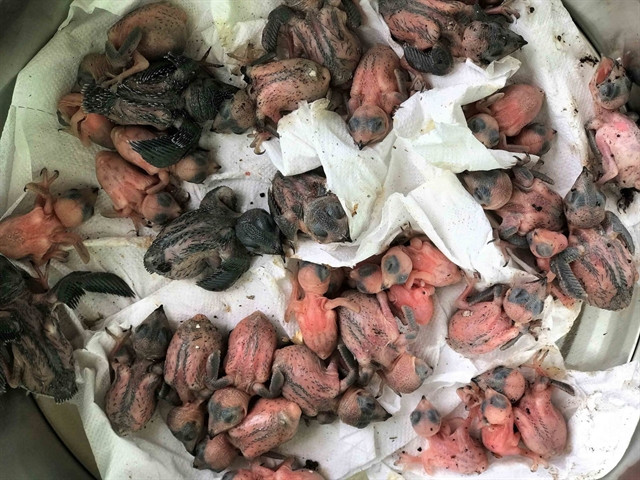 Baby birds which fall from their nests are rescued by workers from the management board of birds’ nests on Cù Lao Chàm Island. VNA/VNS Photo
Baby birds which fall from their nests are rescued by workers from the management board of birds’ nests on Cù Lao Chàm Island. VNA/VNS PhotoThe nests of swallows are made from their saliva, which is a popular foodproduct across Asia. A report from the Ministry of Science and Technology saidVietnamese Salangane nests (known as yen sao) are seen as one of the bestproducts in Vietnam due to their high nutritional value, with 50 percentprotein.
Ca Cave, one of the island's caves, was chosen as the best place to deploy manyscientific projects, in an effort by the Hoi An city's authorities to raise anddevelop swallows.
Dr Vo Tan Phong, an official from the management board of birds’ nests on CuLao Cham Island, told the Vietnam News Agency’s Tin Tuc (News) online newspaperthat the reproduction rate of swallows has improved in recent years.
In May this year, workers collected 1,000 eggs and 800 baby birds that hadfallen from their nests, incubating them at a rescue centre.
All young birds are cared for before being released back into their naturalenvironment, said Nguyen Len, head of the Cu Lao Cham rescue team.
The rate of eggs hatching and young birds developing well has reached 80 percent.
"It is a great success raising them," Phong said.
Wild swallows often build their nests in the caves on the island.
Workers have to build bamboo scaffoldings in caves to reach the birds' nets.
For narrow ravines, workers have to use ropes to get past the wet and slipperyrocks to remove each nest, adding that they are also very careful to avoidtearing the nest, affecting its value, Len said.
The harvested birds' nests are cleaned and divided into many types, based onthe size and volume.
About 90 percent of the nests are exported to Hong Kong (China) and other Asiancountries, while 10 percent are consumed domestically.
Vice-Chairman of the Hoi An City People's Committee Nguyen The Hung the numberof swallows on the island has sharply decreased in recent years.
The city has assigned a management board of birds’ nests on Cu Lao Cham Island,to assess the causes of the decline and further develop projects on rescuingbaby birds and incubating bird's eggs./.




























